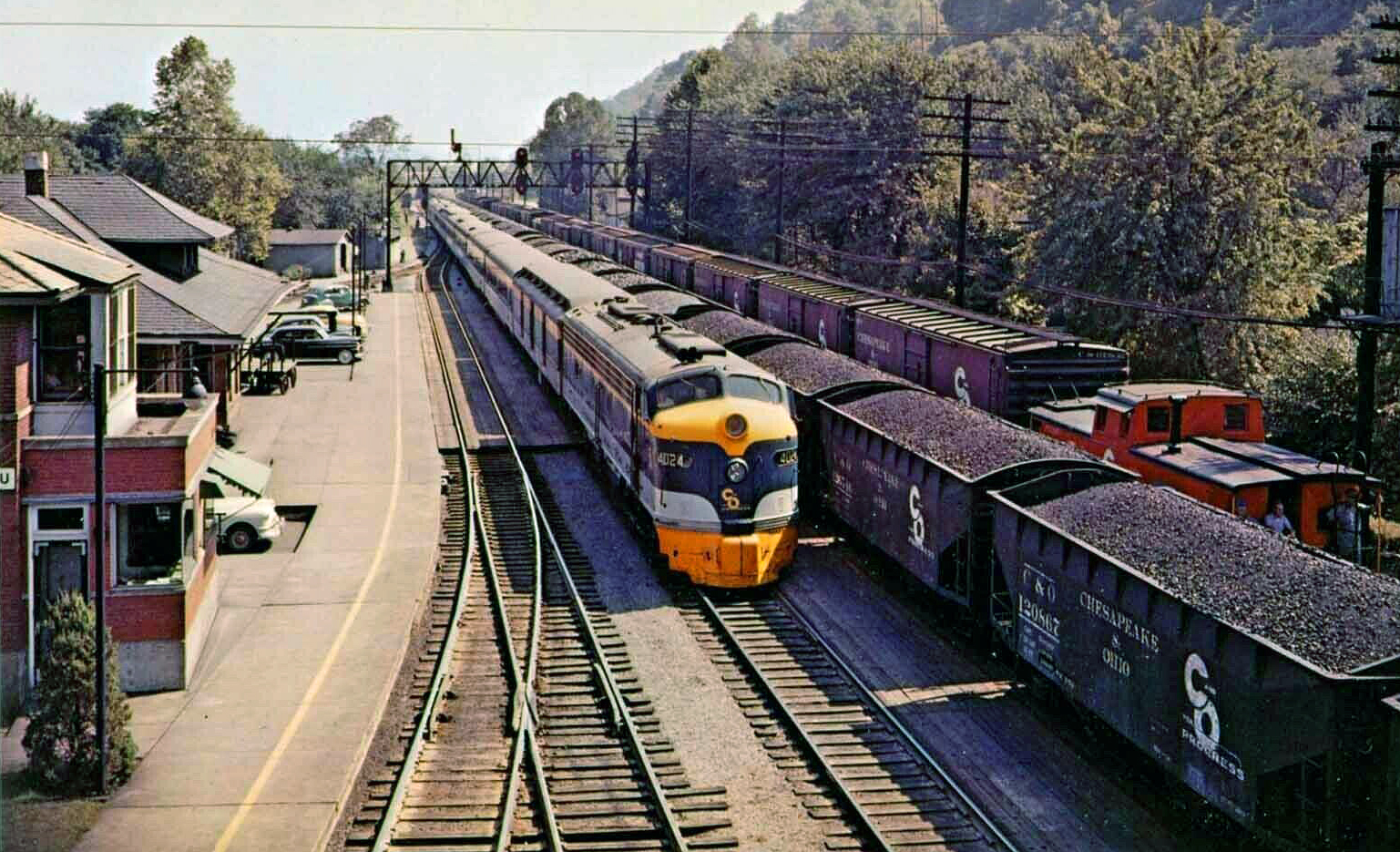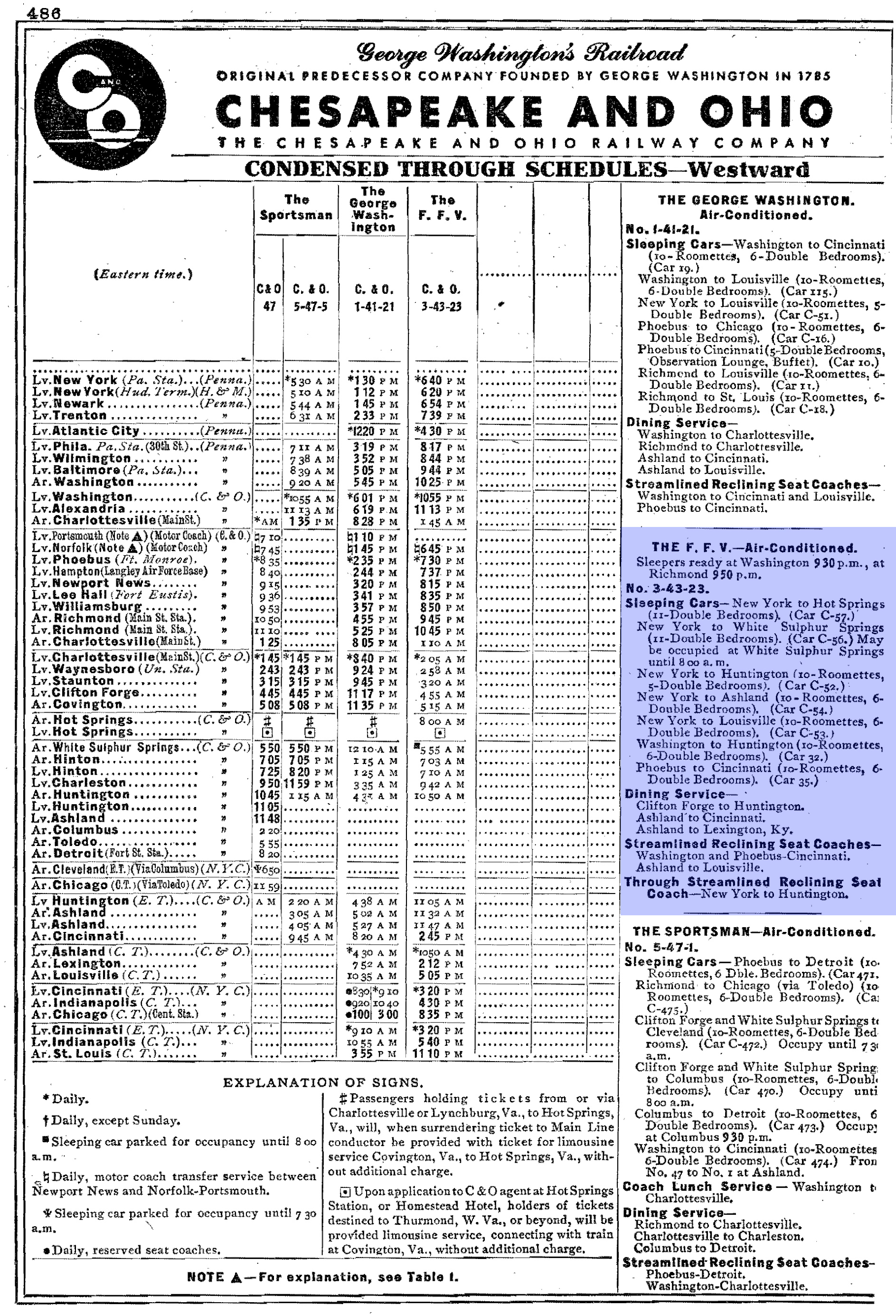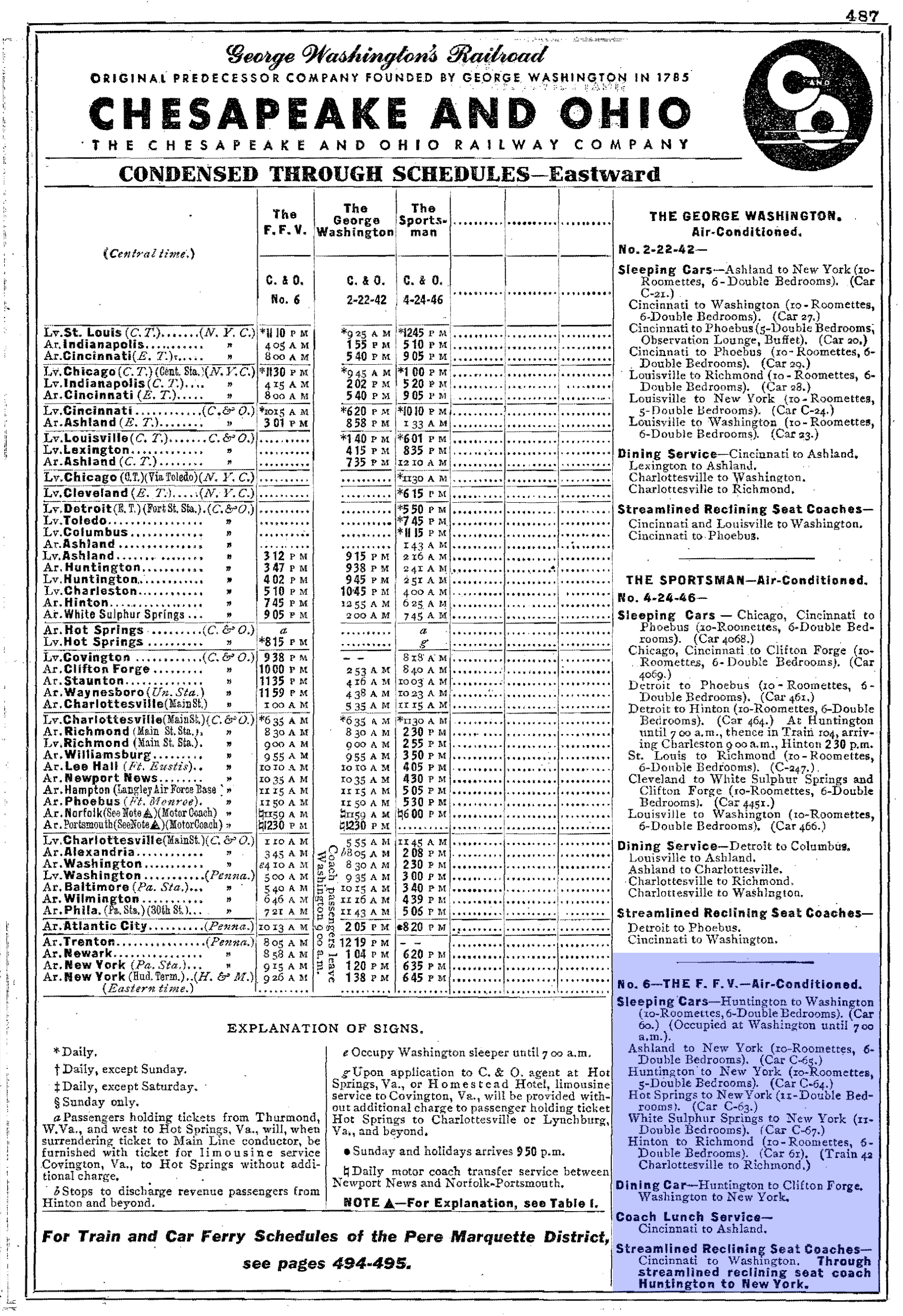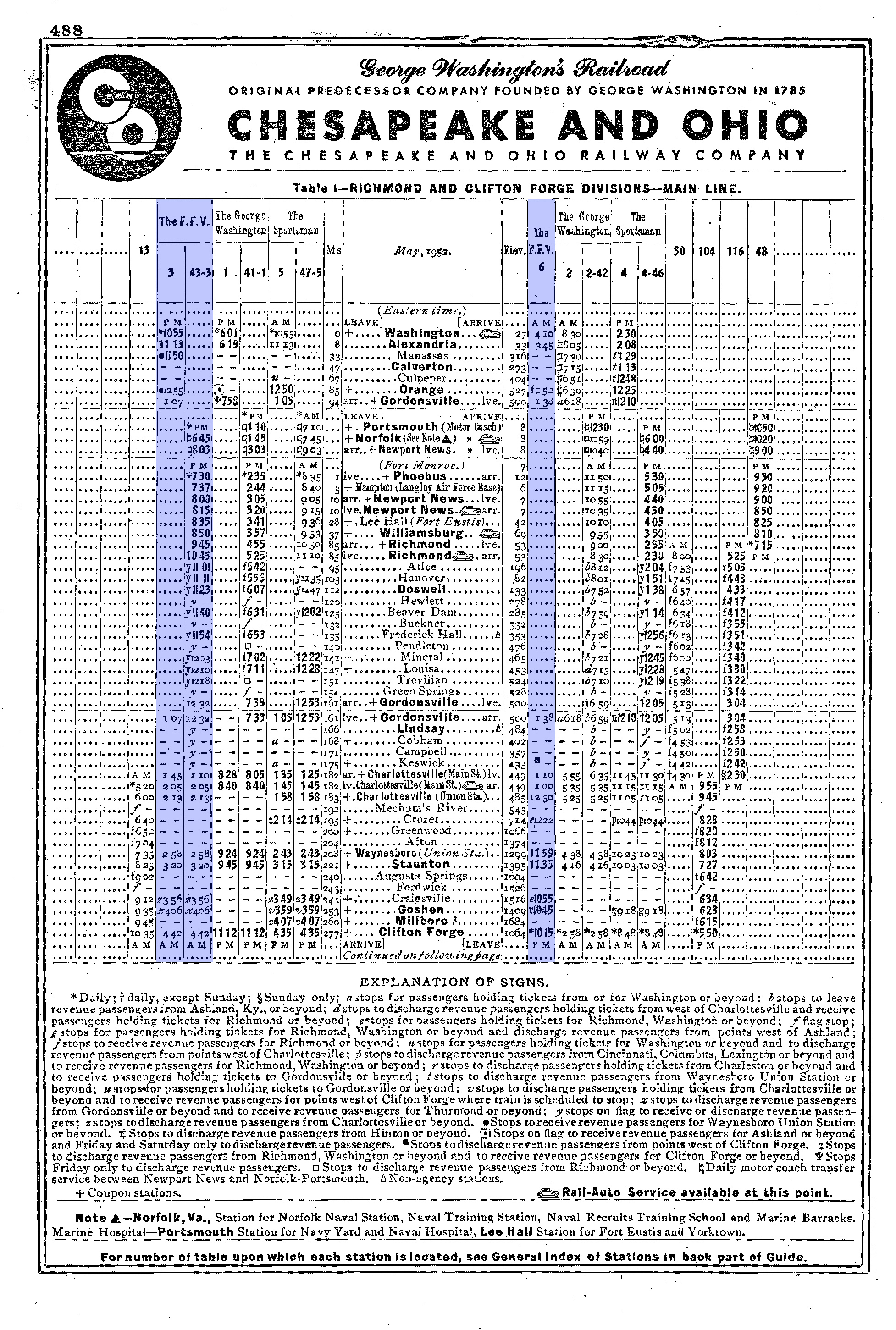Fast Flying Virginian (Train): Timetable, Route, Consist
Last revised: February 27, 2025
By: Adam Burns
Chesapeake & Ohio's Fast Flying Virginian did not begin life as a streamliner. Its heritage dates back to the late 19th century and for many years was C&O's flagship service between
Washington, D.C. and Cincinnati.
The FFV was one of the railroad's oldest and longest lasting, remaining on the timetable for 79 years. With the streamliner's introduction it was eclipsed by the George Washington.
However, as Thomas Dixon notes in his book, "Chesapeake & Ohio Passenger Service: 1847-1971," it was the F.F.V . which trailblazed first-class service on the C&O.
The F.F.V offered guests incredibly scenic views of eastern Virginia and southern West Virginia on its daytime run through the Shenandoah Valley and Appalachian Mountains.
In the 1940s the train was streamlined although received no new equipment after that time. The train remained in service until its 1968 discontinuance following the cancellation of U.S. mail contracts the previous year.
Photos
 In this Chesapeake & Ohio publicity photo train #3, the westbound "Fast Flying Virginian," rolls to a stop at Russell, Kentucky on its way to Cincinnati at 11:05 AM on a summer's day in the 1950's.
In this Chesapeake & Ohio publicity photo train #3, the westbound "Fast Flying Virginian," rolls to a stop at Russell, Kentucky on its way to Cincinnati at 11:05 AM on a summer's day in the 1950's.Inauguration
The C&O's Fast Flying Virginian was the railroad's first full-service named train when it entered service on May 11, 1889 as #3 (westbound) and #6 (eastbound).
The company had recently partnered with the Pennsylvania to provide through car connections to Philadelphia and New York, a major step forward in its efforts then to provide long-distance service.
In addition, the Newport News and Washington sections were combined at Charlottesville, Virginia for their journey westward. Its early consist from January, 1891 notes the following:
"Nos. 3 and 4 consisting of composite car, elegant day coach with smoking saloon and lavatories similar to those in Pullman parlor cars, and Pullman sleeping cars vestibuled from end to end, heated by steam, drawn from the engine and lighted electricity, run through solid, without change, between Cincinnati and New York, via Washington with Pullman vestibule sleeping car between Louisville and Washington, via Huntington."
Since the C&O did not serve the nation's capital directly the F.F.V. operated over Southern trackage rights between Orange and Alexandria, Virginia. In 1908 the railroad reached Chicago directly via acquisition of the Chicago, Cincinnati & Louisville Railroad.
While the F.F.V. remained a Washington/Newport News-Cincinnati service, Mike Schafer and Joe Welsh note in their book, "Streamliners: History Of A Railroad Icon," the C&O was an important interline Pullman link with through cars reaching such destinations as New York, Chicago, St. Louis, and Cleveland.
Early Years
At the time of the F.F.V.'s inauguration only a handful of railroads offered luxurious, named trains. Heavyweight cars, with their trademark celestory roofs, became common after 1910-1911.
During its early years the F.F.V. was led by 4-6-0s in mountainous territory while 4-4-0s typically were used in less rugged areas. In the late steam era either 4-6-2s, or beefier 4-8-2s (the so-called "Mountain" developed by the C&O itself), to power the train.
Even more powerful 4-8-4 "Greenbriers," a fine locomotive built by Lima between 1935-1948, were typically assigned to all trains between Charlottesville and Hinton.
Streamlined Era
In 1942 the railroad gained a new chairman named Robert R. Young who firmly believed in providing top notch passenger service. As such it was not long before the C&O was ordering new cars to completely reequip its fleet with some names like the Sportsman and George Washington, relatively new runs that had only debuted between 1930 and 1932.
In 1944 young ordered 14 new lightweight cars from Pullman for its new Pere Marquettes (Detroit - Grand Rapids) while two large orders were came in 1946 - 46 cars from Budd and other 287 from Pullman.
With The Chessie's cancellation and the railroad realizing its huge order was largely unneeded it ulimately retained only 130 cars. The George Washington was always the railroad's flagship service but the new lightweight cars nevertheless allowed the Fast Flying Virginian to be partially reequipped.
Consist (1952)
Along with the new cars the C&O purchased four E7s in 1948 (#95-98), thirty-one E8s between 1951-1953 (#4000-4030), and sixteen FP7s in 1952 (#8000-8015).
The new trains came equipped with the latest in accommodations such as air-conditioning, spacious seating, and fine dining.
Timetables
(The below Fast Flying Virginian timetable is dated effective April 30, 1967. Technically, eastbound train #4 listed here is the Sportsman.)
| Time/Leave (Train #3/Fast Flying Virginian) | Milepost | Location | Time/Arrive (Train #4/Sportsman) |
|---|---|---|---|
| 10:40 PM (Dp) | 0.0 | 4:15 PM (Ar) | |
| 10:58 PM | 8 | 3:39 PM | |
| F 12:28 AM | 85 | 2:14 PM | |
| 12:41 AM | 94 | 2:00 PM | |
| 1:09 AM (Ar) 1:56 AM (Dp) | 115 | 1:35 PM (Dp) 1:05 PM (Ar) | |
| 128 | F 12:44 PM | ||
| 2:48 AM | 141 | 12:25 PM | |
| 3:26 AM | 154 | 12:01 PM | |
| 5:03 AM | 210 | 10:31 AM | |
| 5:26 AM | 223 | 10:01 AM | |
| 6:11 AM | 245 | 9:20 AM | |
| 6:36 AM | 256 | 9:00 AM | |
| 6:57 AM | 269 | 8:35 AM | |
| 7:39 AM | 290 | 8:04 AM | |
| F 7:55 AM | 303 | ||
| 8:15 AM | 313 | 7:15 AM | |
| 8:35 AM | 324 | 6:56 AM | |
| 9:09 AM | 344 | ||
| 9:36 AM | 361 | 6:06 AM | |
| F | 371 | ||
| 10:27 AM | 387 | 5:30 AM | |
| 10:47 AM | 399 | ||
| 11:31 AM (Ar), 11:50 AM (Dp) | 437 | 4:13 AM (Dp), 3:57 AM (Ar) | |
| 12:16 PM (Ar), 12:26 PM (Dp) | 453 | 3:31 AM (Dp), 3:04 AM (Ar) | |
| F 12:35 PM | 457 | 2:57 AM | |
| 1:10 PM | 484 | 2:21 AM | |
| F 1:31 PM | 505 | ||
| 2:08 PM | 535 | 1:18 AM | |
| F 2:28 PM | 552 | ||
| 3:18 PM | 594 | 12:08 AM | |
| 3:55 PM | 599 | 11:50 PM |
(The below timetable includes the F.V.V./Sportmans Newport News Section dated effective April 30, 1967.)
| Time/Leave (Train #3-43/Fast Flying Virginian) | Milepost | Location | Time/Arrive (Train #4-46/Sportsman) |
|---|---|---|---|
| 8:05 PM (Dp) | 0.0 | 5:25 PM (Ar) | |
| 8:15 PM | 4 | 5:13 PM | |
| 8:30 PM | 18 | 4:58 PM | |
| 8:42 PM | 27 | 4:45 PM | |
| 9:35 PM (Ar), 10:15 PM (Dp) | 75 | 3:55 PM (Dp), 3:45 (Ar) | |
| 11:39 PM | 151 | 2:16 PM | |
| 12:20 AM (Ar) | 172 | 1:50 PM (Dp) |
1952
Final Years
Unfortunately, the C&O's efforts to enter the postwar streamliner fray did little to retain ridership. As traffic continued to fall, the railroad took efforts to reduce or remove unprofitable services from the timetable.
During 1962 the C&O canceled the eastbound F.F.V. and by 1968 all of the railroad's notable east-west trains were combined into one eastbound and westbound run with connections still offered to other various points.
Finally, on May 12, 1968 the Chesapeake & Ohio officially discontinued the F.F.V. after almost 80 years of continuous service.
Sources
- Dixon, Thomas W. Chesapeake And Ohio Railway: A Concise History And Fact Book. Clifton Forge: Chesapeake & Ohio Historical Society, 2012.
- Dixon, Thomas W. Chesapeake & Ohio K-4 Class 2-8-4 Steam Locomotives. Clifton Forge: Chesapeake & Ohio Historical Society, 2013.
- Dixon, Thomas W. Chesapeake & Ohio Passenger Service: 1847-1971. Clifton Forge: Chesapeake & Ohio Historical Society, 2013.
- Schafer, Mike and Welsh, Joe. Streamliners, History of a Railroad Icon. St. Paul: MBI Publishing, 2003.
Recent Articles
-
Rio Grande 2-8-2 Locomotives (K-37): Specs, Roster, Photos
Apr 15, 25 12:57 PM
Rio Grande's Class K-37 Mikes were itsdge steamers to enter service in the late 1920s. Today, all but two survive. -
Rio Grande 2-8-2 Locomotives (K-36): Specs, Roster, Photos
Apr 15, 25 11:09 AM
The Rio Grande's K-36 2-8-2s were its last new Mikados purchased for narrow-gauge use. Today, all but one survives. -
Rio Grande 2-8-2 Locomotives (Class K-28): Specs, Roster, Photos
Apr 14, 25 10:24 PM
Rio Grande's Class K-28 Mikados were its newest narrow-gauge steam locomotives since the Mudhens of the early 1900s. Today, three survive.





